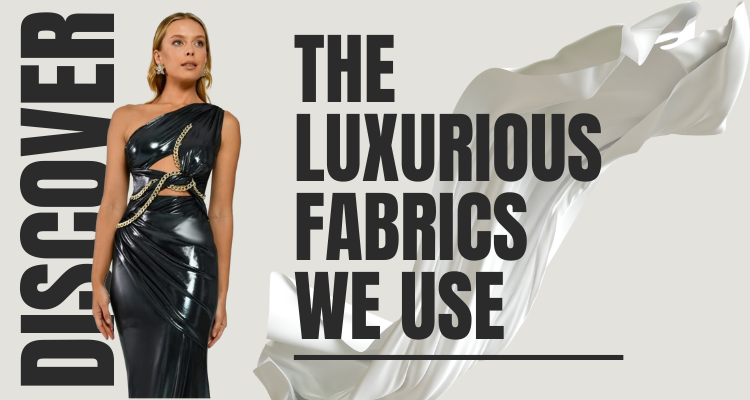Ever wondered what makes a dress truly special? It's not just about the cut or the color – the fabric plays a vital role! Here at Her Closet Mtl, we're obsessed with using the finest materials to craft our stunning dresses. From the soft caress of silk to the unique shine of lame, each fabric brings its own unique personality to a garment. In this blog post, we're diving deep into the world of dress fabrics, helping you understand how the material choice can elevate your look and feel. Get ready to learn about the characteristics and benefits.
Metallic - Lame
Lame fabric is a type of cloth with metallic threads. It is usually made of natural materials like silk, viscose, cotton, wool or synthetic fibers like polyester, polyamide, nylon.
‘Lame’ in translation from French is a ‘metal plate’. This fabric came to us from antiquity, it was mentioned in ancient Assyrian cuneiform writings. Shining with gold or silver patterns, it was used for vestments of priests and clothes of the rich nobility to emphasize the high social status

Satin- Glossy
Satin is one of the three major textile weaves, along plain weave and twill. The satin weave creates a fabric that is shiny, soft, and elastic with a beautiful drape. Satin fabric is characterized by a soft, lustrous surface on one side, with a duller surface on the other side.
Historically, satin was used for upholstery — for example, Louis XIV used it to cover his ornate furniture in the Palace of Versailles. These days it is commonly used for evening gowns, lingerie, boxer shorts, ballet shoes, hats, ties and bedding.

Glitter Fabric
Glitter fabrics are known for their distinctive shimmer and shine, which is achieved through the incorporation of glitter particles into the fabric.
Fine Glitter Fabric: As the name suggests, fine glitter fabric consists of smaller glitter particles that give a more subtle and elegant look. It is commonly used in garments like evening gowns, blouses, and skirts for adding a touch of sophistication without overwhelming the overall design.

Shiny - Luster
In textiles, lustre or luster is a physical property that makes them appear bright, glossy, and shiny. The amount of light reflected from the surface of a fiber is referred to as its luster. This type of fabric tends to be more structured compared to satin.

Weaving Glitter Yarn
Lurex fabric is a highly elastic and flexible mesh composed of metallic threads; The concept of lurex fabric emerged from the vision of infusing a metallic shine into the fabric's thread. This gives the look of glitter peaking through the fabric.
With a history dating back to 1946, these fabrics have thrived alongside technological advancements in the textile industry. It quickly gained popularity in the 1970s, and designers such as Jacques Griffe have embraced it for its ability to infuse fashion with charm. Lurex textile has evolved over time while retaining its timeless appeal, providing a hint of retro sophistication.

Sequence - “Sequin”
Sequin fabric is a type of fabric covered with plastic or metal shaped pieces. It is also commonly referred to as ‘sequence fabric’, though the only correct term is ‘sequin’. Sequins vary in size, shape and color.
Coins have been fastened to clothes for generations to keep the wealth of the possessor close and secure. Nomadic societies and funeral clothes were especially fond of it in ancient times.
There is a lot of debate over the origins of “sequin.” However, it can be traced back to the Arabic term Sikka (coin). The word “sequin” was first used in France in the late 1600s.


